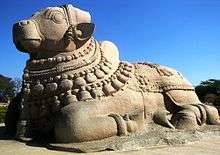Recherla Nayaks
Recherla Nayaks were an Andhra dynasty that wrested power from the Musunuri Nayaks after the death of Kapaya Nayaka and became the dominant power in the Telangana region during the late 14th century.[1] Even though modern historians of Andhra identify the Recherla Nayaks with Velamas, Cynthia Talbot states that the formation of the Velama community dates to a later period, the mid-sixteenth century at the earliest.[2]
History
The Recherla Nayaks are believed to have established their first base at Amanugallu. When their chief Singama Nayaka was assassinated by rivals, his son Musunuri Anapota Nayaka blamed Kapaya Nayaka as the orchestrator and marched on Warangal. In a battle fought at Bhimavaram in 1368, Kapaya Nayaka was killed and the Recherlas got control of Telangana.[3] Anapota Nayak later claimed, in an inscription issued in 1369, that his grandfather, Dachaya, had served as a chief under the Kakatiyas and that Prataparudra II conferred on him the title Pandya-raja-gaja-kesari (a lion against the Pandya elephants).[4] The Recherla Nayaks built two fortified towns at Rachakonda and Devarakonda in the Nalgonda district.[1]
The Recherlas had as their rivals the Reddy dynasty in the coastal Andhra region. They were initially allied with the Bahmani sultanate, following the same terms of agreement as reached by the Musunuri Nayaks in 1364, whereas the Reddys were allied to the Vijayanagara Empire. Following a split among the Reddy clan, the Kondavidu Reddys switched their allegiance to the Bahmanis and the Recherlas aligned themselves with the Vijayanagara. A major battle ensued at Panagal, Nalgonda district in 1419 in which the coalition of the Vijayanagara, Recherlas and Rajahmundry Reddys was victorious. However, the change of allegiance by Recherlas led to attacks by the Bahmani sultanate in the 1420s, who captured Warangal as well as Rachakonda by 1935. Thereafter, the Recherla chiefs remained small players scattered throughout Telangana.[5]
References
- 1 2 Talbot 2001, p. 177.
- ↑ Talbot 2001, p. 191.
- ↑ Prasad 1988, p. 172.
- ↑ Talbot 2001, p. 179.
- ↑ Talbot 2001, pp. 180-181.
- Sources
- Prasad, G. Durga (1988), History of the Andhras up to 1565 A. D. (PDF), Guntur: P. G. Publishers
- Talbot, Cynthia (2001), Pre-colonial India in Practice: Society, Region, and Identity in Medieval Andhra, Oxford University Press, ISBN 978-0-19803-123-9
